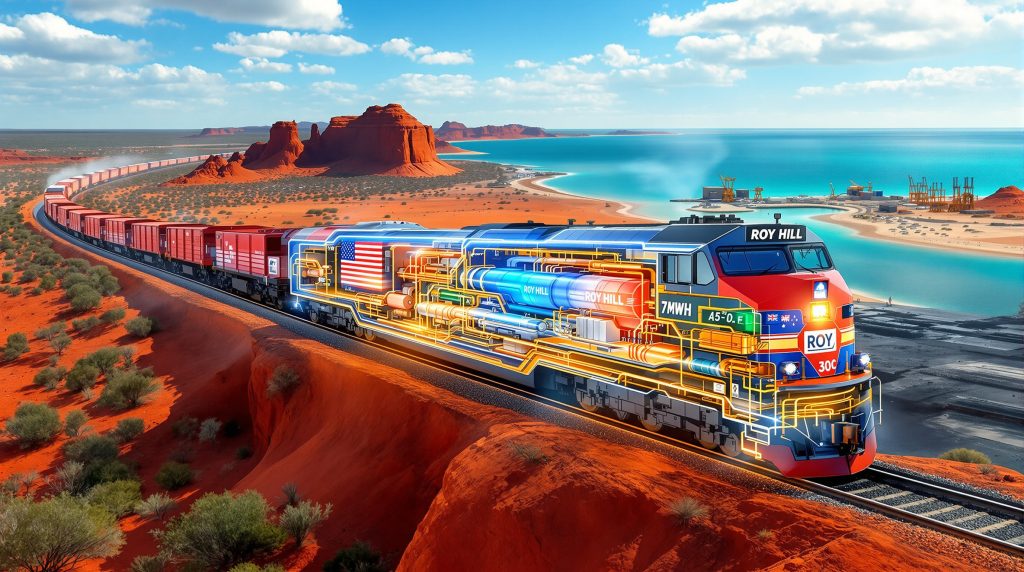Revolutionary Technology Powers Mining's Green Future
Australia's mining sector has witnessed a transformative milestone with the arrival of Australia's first battery-electric locomotives specifically engineered for the demanding conditions of heavy-haul operations. These groundbreaking rail systems mark a decisive shift away from traditional diesel dependency, incorporating sophisticated energy storage technologies and regenerative systems that leverage the unique geographical advantages of Australian mining routes. Furthermore, this advancement aligns perfectly with broader electric vehicles transforming mining initiatives across the sector.
The technological breakthrough centers on advanced 7-megawatt-hour battery configurations integrated with cutting-edge regenerative braking mechanisms. This innovative combination enables locomotives to capture gravitational energy during loaded descents from elevated mining sites to coastal port facilities, storing this recovered power for subsequent uphill return journeys to mining operations.
Mining Industry Leaders Driving Electric Rail Innovation
BHP's Pilbara Electric Locomotive Deployment
BHP Group has positioned itself at the forefront of Australia's electric locomotive revolution through strategic collaboration with global rail technology specialist Wabtec to introduce the nation's first purpose-designed battery-electric heavy-haul locomotives. These revolutionary units have been specifically engineered to withstand the extreme environmental challenges characteristic of Western Australia's Pilbara region, where operational temperatures frequently exceed 40°C and dust storms create exceptionally demanding conditions. In addition, this initiative supports BHP's broader electric vehicle deployment across their mining operations.
The deployment encompasses comprehensive real-world testing across BHP's extensive iron ore transportation network, focusing on the critical route connecting Pilbara mining operations with Port Hedland facilities. This testing program will systematically evaluate performance metrics including energy efficiency, operational reliability, and maintenance requirements under actual commercial mining transport conditions.
Tim Day, BHP Western Australia Iron Ore Asset President, characterised the deployment as representing years of intensive planning, problem-solving and strategic partnership development. The trial aims to establish how this technology can effectively reduce diesel consumption, lower associated operational greenhouse gas emissions, and improve overall efficiency across the company's rail network.
Advanced Energy Recovery Systems
The locomotives incorporate sophisticated regenerative braking technology that transforms kinetic energy into stored electrical power during operational cycles. When heavily loaded trains descend from elevated mining locations, the braking process captures energy that would traditionally be dissipated as heat through conventional friction braking systems. This advancement complements the broader renewable energy integration strategies being implemented across Australian mining operations.
This captured energy flows directly into high-capacity battery storage systems, effectively converting each loaded journey into an energy generation cycle. The technology proves particularly effective on iron ore transportation routes where significant elevation differences between mining sites and port facilities create optimal conditions for energy recovery and storage.
Peter Thomas, Wabtec's Regional Senior Vice President for ANZ & SEA, emphasised that these locomotives are purpose-built to perform in one of the world's most demanding environments, combining advanced battery technology and regenerative braking to deliver enhanced efficiency and reduced emissions.
Technical Specifications and Capabilities
| Specification | Technical Details |
|---|---|
| Battery Capacity | 7 megawatt-hours (MWh) per locomotive |
| Propulsion System | 100% battery-electric operation |
| Energy Recovery | Advanced regenerative braking technology |
| Operating Environment | Extreme heat and dust conditions (40°C+) |
| Trial Location | Pilbara mines to Port Hedland route |
| Load Configuration | Heavy-haul iron ore transport |
| Charging Method | Self-sustaining through energy recovery |
| Deployment Status | Two units undergoing live track trials |
Environmental Impact and Operational Benefits
Greenhouse Gas Emissions Reduction Strategy
The Australia's first battery-electric locomotives specifically target reductions in operational greenhouse gas emissions, addressing both Scope 1 and Scope 2 emissions categories that directly impact mining companies' environmental reporting obligations and carbon reduction commitments. This technology alignment supports increasing regulatory pressure and investor expectations for sustainable mining operations across the Australian resources sector. Moreover, these developments contribute significantly to the broader energy transition in mining sector transformation.
The locomotives are optimised for performance while maintaining focus on environmental objectives, representing a significant technological advancement in heavy-haul rail transport sustainability. The integration of regenerative braking systems enhances operational efficiency while simultaneously reducing waste energy traditionally lost during braking operations.
Operational Efficiency Improvements
Electric propulsion systems offer substantial advantages over traditional diesel locomotives through reduced mechanical complexity and associated maintenance requirements. The technology provides greater energy cost predictability compared to volatile diesel fuel markets, enabling more accurate long-term operational budgeting and strategic planning.
The locomotives maintain compatibility with existing rail infrastructure, track systems, and operational protocols while delivering enhanced environmental performance. This compatibility reduces implementation costs and deployment timelines compared to electrified rail systems requiring extensive overhead power infrastructure development.
Strategic Partnerships Enabling Technology Success
Wabtec's Technology Leadership
Wabtec Corporation contributes decades of locomotive manufacturing expertise and advanced electric propulsion technology specifically designed for heavy-haul applications. The FLXDrive platform represents extensive research and development investment in battery-electric rail systems, engineered to meet the demanding requirements of Australian mining operations. Furthermore, these innovations complement AI in mining innovation developments being implemented across the sector.
The collaborative partnership model combines Wabtec's technological capabilities with Australian mining companies' extensive operational expertise, ensuring locomotive designs meet the specific environmental and performance requirements of Pilbara mining conditions and transportation demands.
Collaborative Development Framework
Successful electric locomotive implementation requires comprehensive collaboration between mining operators, technology providers, and specialised support organisations. These partnerships address complex integration challenges including system commissioning, operator training programs, maintenance protocol development, and continuous performance optimisation processes.
The collaborative approach ensures long-term operational success through shared technical expertise, risk mitigation strategies, and systematic improvement processes that enhance locomotive performance throughout extended operational periods.
Operational Challenges and Solutions
Extreme Environmental Conditions
Australia's mining regions present some of the world's most challenging operating environments for sophisticated electrical equipment and systems. Temperatures consistently exceeding 40°C, abrasive dust conditions, and remote operational locations require robust engineering solutions and specialised maintenance approaches to ensure reliable performance.
Battery systems must maintain consistent performance and longevity under these extreme environmental conditions while providing reliable power output throughout extended operational cycles. Advanced thermal management systems and specialised protective enclosures address these significant environmental challenges.
Remote Location Support Infrastructure
Remote mining locations present unique challenges for specialised maintenance and technical support services required for advanced electric locomotive systems. These sophisticated rail systems require trained technicians, specialised diagnostic equipment, and readily available replacement components to maintain optimal operational reliability.
Mining companies must develop comprehensive maintenance strategies addressing both routine servicing requirements and emergency repair capabilities in locations significantly distant from major service centres and technical support facilities.
Industry Scaling and Future Applications
What Are the Technology Adoption Projections?
The successful deployment of initial Australia's first battery-electric locomotives establishes a technological foundation for broader industry adoption across Australia's diverse mining sector. Major mining companies are monitoring performance results and economic benefits to inform their electrification strategies and investment decisions. Consequently, this aligns with developments in electric locomotive technology across various mining operations.
Industry projections indicate accelerating adoption rates as technology costs decrease, performance validation demonstrates operational benefits, and regulatory pressure increases for emissions reduction across the mining industry.
Technology Evolution and Enhancement
Ongoing technological development will enhance battery capacity, charging efficiency, and operational reliability while reducing overall system costs. These continuous improvements will expand the applicability of electric locomotives to additional mining operations and diverse transportation routes.
Future technological developments may include wireless charging systems, improved battery chemistry formulations, and enhanced energy management software that further optimise locomotive performance and operational efficiency across various mining applications.
Broader Transportation Applications
How Can This Technology Expand Beyond Mining?
The demonstrated success of battery-electric locomotives in demanding mining applications creates significant opportunities for broader rail transport electrification across Australia's freight and passenger networks. The technology's proven performance under extreme conditions validates its viability for diverse transportation applications and operational environments.
Future applications may extend to general freight transportation, regional passenger services, and urban rail networks as battery technology continues improving and implementation costs decrease across the transportation sector.
Renewable Energy Integration Opportunities
Electric locomotives create strategic opportunities for integration with renewable energy generation systems, including solar and wind power installations at mining sites and along transportation corridors. This integration could further reduce operational emissions while providing enhanced energy cost stability through on-site power generation capabilities. Additionally, these systems benefit from advances in battery recycling advancements that support circular economy principles.
The combination of renewable energy generation, advanced battery storage, and electric locomotive technology represents a comprehensive approach to sustainable mining operations that addresses multiple environmental and economic objectives simultaneously.
Mining Route Optimisation for Electric Operations
Topographical Advantages in Australian Mining
Australian mining regions, particularly the Pilbara, feature unique topographical characteristics that create optimal conditions for battery-electric locomotive operations. Iron ore mining sites typically operate at elevated locations, with established rail routes descending toward coastal port facilities for export operations.
This consistent elevation profile across multiple mining operations enables standardised locomotive configurations and predictable energy generation patterns, supporting reliable operational planning and systematic performance optimisation across the mining network.
Infrastructure Integration Benefits
Existing rail infrastructure requires minimal modification to accommodate battery-electric locomotives, as current track systems, signalling equipment, and established operational protocols remain largely compatible. This infrastructure compatibility significantly reduces implementation costs and deployment timelines.
The locomotives integrate seamlessly with existing train consist configurations, maintaining compatibility with current rolling stock and established operational procedures while delivering substantial environmental performance improvements.
Economic and Strategic Implications
Cost Structure Transformation
Battery-electric locomotives represent a fundamental shift in mining transportation cost structures, moving from variable fuel-dependent operations to more predictable electricity-based energy costs. This transformation enables enhanced financial planning and operational budgeting accuracy.
The technology reduces dependency on volatile diesel fuel markets while providing opportunities for strategic energy procurement and renewable energy integration that further optimise operational costs over extended periods.
Strategic Positioning for Decarbonisation
The deployment of Australia's first battery-electric locomotives positions the mining industry strategically for broader decarbonisation objectives and evolving environmental regulations. This proactive technology adoption demonstrates industry commitment to sustainable operations while maintaining operational efficiency.
Mining companies implementing electric locomotive technology gain competitive advantages through reduced emissions profiles, enhanced operational efficiency, and alignment with increasing investor and regulatory expectations for environmental stewardship.
Performance Monitoring and Optimisation
What Testing Protocols Are Being Used?
The locomotives undergo comprehensive live track trials designed to assess technology performance under actual commercial operating conditions. These testing protocols evaluate energy efficiency, operational reliability, maintenance requirements, and overall system performance across extended operational periods.
Performance data collection encompasses:
• Energy consumption and regeneration efficiency metrics
• Battery performance under extreme temperature conditions
• Operational reliability across diverse load configurations
• Maintenance requirement analysis and optimisation opportunities
• Environmental impact measurement and verification
Continuous Improvement Framework
Systematic performance monitoring enables continuous improvement processes that optimise locomotive efficiency and operational capabilities. This framework supports ongoing technology refinement and enhancement based on real-world operational experience and performance data analysis.
The improvement framework facilitates knowledge transfer across the mining industry, accelerating broader adoption through shared learning and technology optimisation insights.
Australia's deployment of Australia's first battery-electric locomotives represents a pivotal transformation in the nation's mining transportation infrastructure, demonstrating successful integration of advanced sustainable technology with heavy-haul operational requirements. The combination of sophisticated battery systems, regenerative braking technology, and Australia's advantageous mining topography creates exceptional conditions for electric locomotive success.
The pioneering initiatives of BHP, supported by Wabtec's technological expertise, establish a robust foundation for industry-wide adoption of electric rail transport technology. As these initial deployments demonstrate operational and economic benefits, the technology will likely expand throughout Australia's mining sector and beyond, contributing significantly to the nation's decarbonisation objectives while maintaining the operational excellence essential to Australia's resource-dependent economic prosperity.
This technological advancement represents more than engineering innovation. It demonstrates the mining industry's capacity for environmental leadership and operational transformation while preserving the productivity and efficiency that underpin Australia's continued economic success in global resource markets.
Disclaimer: This article contains forward-looking statements regarding technology adoption, performance projections, and industry trends. Actual results may vary based on operational conditions, market factors, and technological developments. Readers should conduct independent research before making investment or operational decisions.
Want to Capitalise on Mining's Green Revolution?
Australia's first battery-electric locomotives represent the kind of technological breakthrough that can transform entire sectors and create significant opportunities for forward-thinking investors. Discovery Alert's proprietary Discovery IQ model identifies ASX mineral discoveries instantly, helping subscribers recognise actionable opportunities in mining technology and sustainable resource companies before the broader market catches on. Begin your 30-day free trial to position yourself ahead of the curve and discover why major breakthroughs can generate exceptional returns through Discovery Alert's dedicated discoveries page.




